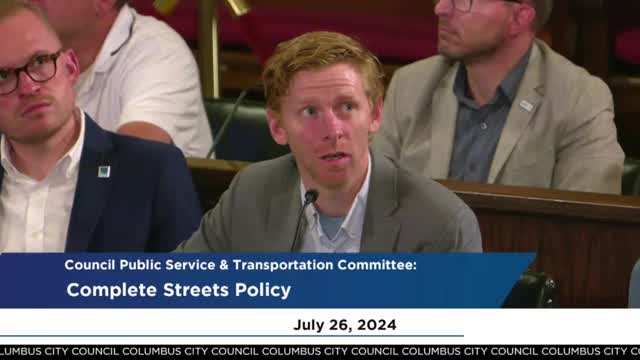City plans bold changes to make streets safer for all
July 27, 2024 | Columbus City Committees (Regular Meetings), Columbus, Franklin County, Ohio

This article was created by AI summarizing key points discussed. AI makes mistakes, so for full details and context, please refer to the video of the full meeting. Please report any errors so we can fix them. Report an error »

In a recent government meeting, officials discussed significant improvements to road safety and infrastructure in Columbus, focusing on the implementation of \"complete streets\" policies aimed at enhancing pedestrian and cyclist safety. The meeting highlighted various projects, including modifications to intersections and roadways that have historically encouraged speeding and posed dangers to non-motorized users.
One key example presented was the intersection at Mount Vernon and Champion, where simple striping and the installation of reboundable posts have successfully narrowed the roadway, reducing the distance pedestrians must cross. This approach is part of a broader strategy to address high injury networks (HIN) identified in the city, which are areas with a high incidence of traffic-related injuries.
East Broad Street was also discussed as a critical area for improvement. Currently a 70-foot-wide roadway with multiple travel lanes, it has been deemed unsafe for pedestrians. Officials emphasized the need for immediate changes rather than waiting for scheduled resurfacing, advocating for short-term solutions that can lead to long-term safety enhancements.
The meeting underscored the importance of collaboration with regional planning organizations, such as the Mid-Ohio Regional Planning Commission (MorPC), to secure funding for these initiatives. Projects like Livingston Avenue are set to transition from a four-lane to a three-lane configuration, incorporating dedicated bike lanes and pedestrian pathways to create a safer environment for all users.
Officials expressed a commitment to formalizing a complete streets policy within the Department of Public Service, which would align with existing guidelines and enhance the design process for future projects. This policy aims to ensure that all roadways are designed with the safety of vulnerable users in mind, recognizing that different areas may require tailored approaches.
The discussions reflect a growing recognition of the need for safer streets in Columbus, with an emphasis on creating infrastructure that accommodates all modes of transportation. As the city moves forward with these initiatives, the focus remains on reducing speeds, improving safety, and fostering a more inclusive environment for pedestrians and cyclists alike.
One key example presented was the intersection at Mount Vernon and Champion, where simple striping and the installation of reboundable posts have successfully narrowed the roadway, reducing the distance pedestrians must cross. This approach is part of a broader strategy to address high injury networks (HIN) identified in the city, which are areas with a high incidence of traffic-related injuries.
East Broad Street was also discussed as a critical area for improvement. Currently a 70-foot-wide roadway with multiple travel lanes, it has been deemed unsafe for pedestrians. Officials emphasized the need for immediate changes rather than waiting for scheduled resurfacing, advocating for short-term solutions that can lead to long-term safety enhancements.
The meeting underscored the importance of collaboration with regional planning organizations, such as the Mid-Ohio Regional Planning Commission (MorPC), to secure funding for these initiatives. Projects like Livingston Avenue are set to transition from a four-lane to a three-lane configuration, incorporating dedicated bike lanes and pedestrian pathways to create a safer environment for all users.
Officials expressed a commitment to formalizing a complete streets policy within the Department of Public Service, which would align with existing guidelines and enhance the design process for future projects. This policy aims to ensure that all roadways are designed with the safety of vulnerable users in mind, recognizing that different areas may require tailored approaches.
The discussions reflect a growing recognition of the need for safer streets in Columbus, with an emphasis on creating infrastructure that accommodates all modes of transportation. As the city moves forward with these initiatives, the focus remains on reducing speeds, improving safety, and fostering a more inclusive environment for pedestrians and cyclists alike.
View full meeting
This article is based on a recent meeting—watch the full video and explore the complete transcript for deeper insights into the discussion.
View full meeting
